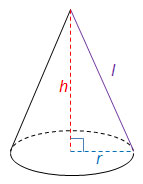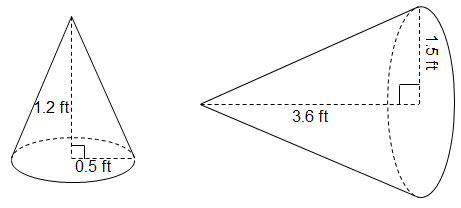In this section, you will investigate relationships of the scale factor in similar cones.
![]() The animation below shows the relationship between the radius, height, and slant height of a cone. In the diagram below, h represents the height of the cone, r represents the radius, and l represents the slant height.
The animation below shows the relationship between the radius, height, and slant height of a cone. In the diagram below, h represents the height of the cone, r represents the radius, and l represents the slant height.
Interactive popup. Assistance may be required.
What polygon is formed by the radius, height, and slant height of a cone?
Interactive popup. Assistance may be required.
Use the Pythagorean Theorem.
Interactive popup. Assistance may be required.
The radii and the heights need to be proportional.
![]() Cones A, B, C, D, and E are similar. One of the cones is shown in the diagram. Some of their lengths are given in the table. Complete the drag and drop puzzle to fill in the table. Drag the appropriate number to its correct place in the table. Click the Reset button if you need to reset the interactive.
Cones A, B, C, D, and E are similar. One of the cones is shown in the diagram. Some of their lengths are given in the table. Complete the drag and drop puzzle to fill in the table. Drag the appropriate number to its correct place in the table. Click the Reset button if you need to reset the interactive.

Interactive popup. Assistance may be required.
Yes
Interactive popup. Assistance may be required.
No
Now, let’s look more closely at the volumes of similar cones. The volumes of three similar cones are shown below. Click on each volume to see how the volume was calculated.
| Volume of Cone A (cubic units) | Volume of Cone B (cubic units) | Volume of Cone C (cubic units) |
![]() Investigate volume relationships by completing the following drag and drop puzzle. Use the information in the volume calculations above to help you. Drag the appropriate tiles to the correct place on the table. Click the Reset button if you need to reset the interactive.
Investigate volume relationships by completing the following drag and drop puzzle. Use the information in the volume calculations above to help you. Drag the appropriate tiles to the correct place on the table. Click the Reset button if you need to reset the interactive.
Use the information in the table you just completed to answer the following questions.
Interactive popup. Assistance may be required.
The ratio of the corresponding lengths is equal to the scale factor.
Interactive popup. Assistance may be required.
The ratio of the volumes is the cube of the scale factor.
Interactive popup. Assistance may be required.
Ratio of the volume of Cone D to Cone A 64:1 = 43:13
How could you generalize the relationship between the scale factor z of two similar cones and the ratios of the volumes of those cones?
Interactive popup. Assistance may be required.
How is the ratio of the volumes of two similar cones related to the scale factor between the dimensions of the similar cones?
Interactive popup. Assistance may be required.
2.53 : 1 = 15.625 : 1

What is the ratio of the volumes of the two cones?
Interactive popup. Assistance may be required.
How is the ratio of the volumes of two similar cones related to the scale factor between the dimensions of the similar cones?
Interactive popup. Assistance may be required.
1:33 : 1 = 1:27 : 1
Interactive popup. Assistance may be required.
How is the ratio of the volumes of two similar cones related to the scale factor between the dimensions of the similar cones?
Interactive popup. Assistance may be required.
15 × (2k)3 = 15 × (8k3) = 120k3